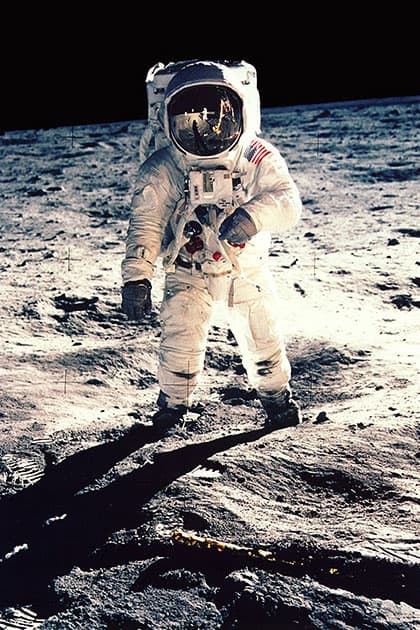
The iconic visor shot featuring Buzz Aldrin, taken by Neil Armstrong. Credit: NASA
Strange as it might now seem, during the early days of space exploration, photography wasn’t considered important. The first man in space was Russian cosmonaut Yuri Gagarin who circled the Earth during a 108-minute flight on 12 April 1961. A weird stop-motion series of pictures of Gagarin during the flight have survived, but sights seen through the window of his spacecraft were never recorded.
That same year Project Mercury, America’s first human spaceflight programme, administered by the National Aeronautics and Space Administration (NASA), took Alan Shepard and Virgil Grissom on the first sub-orbital flights. Cameras were on board only to document instrument readings.
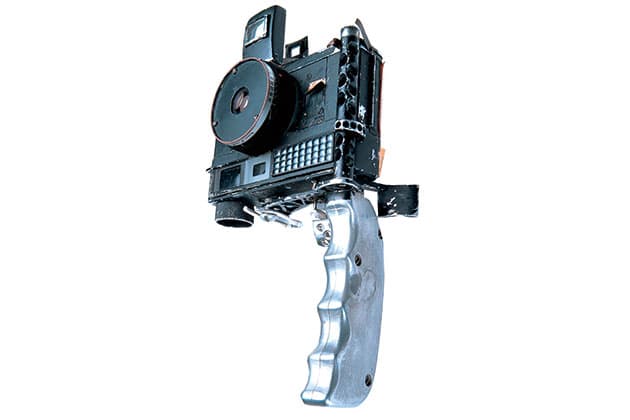
The Autoset used by astronaut John Glenn (Transferred from NASA to the Smithsonian Institution, National Air and Space Museum). Credit: John Wade
First cameras in space
The following year Colonel John Glenn made the first American orbital flight in space, leaving the Earth’s atmosphere and circling the planet three times. Although a major landmark in the American space programme, the only cameras on board were a Leica, supplied by NASA, and a modified Ansco Autoset, which Glenn bought at a local drug store.
The Autoset was a simple, non-reflex, 35mm camera with manual and automatic exposure. For its trip into space, the camera was stripped back to its bare metal, a pistol grip was attached to the top with links to the shutter release and film advance lever and a direct vision viewfinder was attached to the base. With the pistol grip held in the astronaut’s gloved hand, the camera was used upside down. The Leica was only slightly modified with a large viewfinder for use with a spacesuit visor.
However, given that the spacecraft’s automatic control system failed after the first orbit and that Glenn was forced to take manual control during not just the second and third orbits, but also during re-entry when the craft’s heat shield became loose, he probably had things other than photography on his mind for much of the flight.
That was in February 1962. In May of the same year, when Scott Carpenter became the second American astronaut to take a spacecraft into orbit, he took a Robot Recorder 36 with him. Robot cameras had built-in clockwork motor drives, and the only significant modification to the store-bought model was the addition of a handle and trigger to make the camera easier to use in gloved hands.
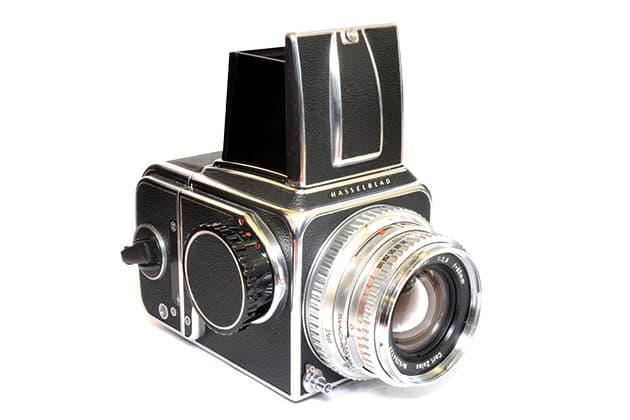
Hasselblad 500 C, the model of camera bought by Walter Schirra for his flight. Credit: John Wade
A major milestone in space-flight photography came in October 1962 when astronaut Walter Schirra completed six orbits of the Earth. He had seen earlier attempts at photography from spacecraft and, being a keen amateur photographer, thought he could do better if he could use the right stuff in terms of photo gear. So he suggested that he would like to use a Hasselblad. ‘Okay, then you had better go and buy one,’ said NASA, or words to that effect. So Schirra dropped into a photographic store in Houston and bought a Hasselblad 500C off the shelf, which he delivered to NASA technicians for a few modifications.
Out went the reflex mirror and focusing screen, replaced by a metal plate across the top of the body. The vinyl covering was removed and all surfaces were painted black. The usual Hasselblad film back that provided 12 images 6x6cm on 120 roll film was modified to take 18ft of extra-thin 70mm-wide film which, with a modified film gate, shot 70 pictures to a roll. The lens was an 80mm f/2.8 Zeiss Planar, slightly modified for ease of use, but optically untouched.
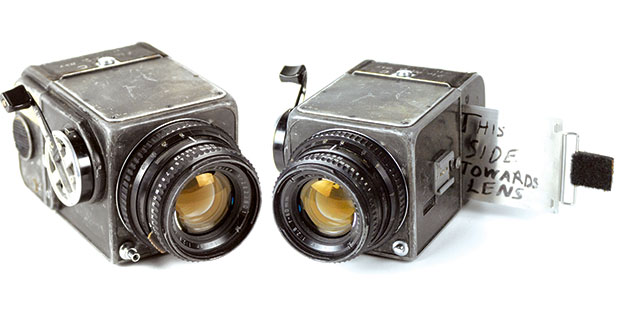
Two views of the first Hasselblad in space. At a 2014 auction a camera sold with provenance to show it was used by astronaut Walter Schirra. Credit: RR Auction, Boston, Massachusetts
In November 2014, a modified Hasselblad 500C, with due provenance and photographic confirmation that supported its claim to be the camera that Schirra took into space, was consigned for auction in Massachusetts. Crudely written on the top of the film back were exposure instructions: f/16, 1/250, day; f/11 1/250 sunrise/set. The camera sold for $275,000.
In 1961, NASA moved from the Mercury to the Gemini Project, a programme used to test equipment and skills needed to put a man on the moon.It included space walks, orbit changes and the separation and docking of two spacecraft. For a few missions a Maurer 70 – rather like an oversized 35mm camera for 70mm film – was taken into space. Then, on the first-ever space walk in 1965, astronaut Ed White aboard Gemini 4 used a Zeiss Ikon Contarex 35mm single lens reflex with a 50mm Zeiss Planar lens. It was attached to a handheld manoeuvring unit containing two compressed oxygen bottles that were fired by the astronaut to help him move around space.
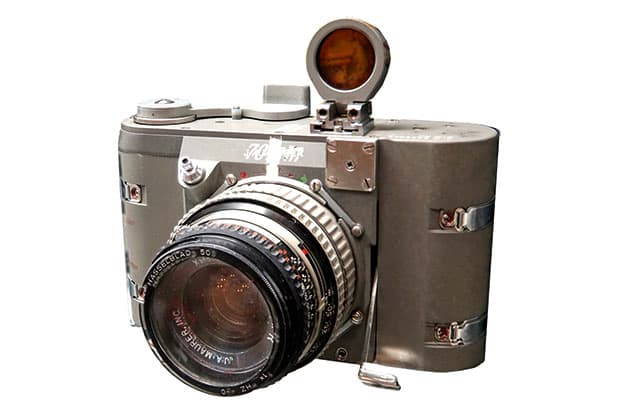
Maurer 70, a type of camera used on Mercury missions. Credit: Sanjay Acharya via Wikimedia Commons
Hasselblad Lunar Surface Camera
With Gemini 9 in 1966, another Hasselblad made its appearance. It was known as the Lunar Surface Camera, which has led some to believe that it was planned for use on the moon’s surface. In fact, it was used to take pictures of the surface, but only from orbiting craft during four Gemini missions.
The Lunar Surface Camera was derived from the Hasselblad Super Wide Camera (SWC) made in 1959, evolving from an earlier model made in 1954. It consisted of a slimline body with the film wind lever on the side and a wideangle viewfinder on top, attached to a film back. There was no room for a reflex mirror, so there was no reflex focusing.

Hasselblad Super Wide Camera, the model that was used as a basis for the Lunar Surface Camera. Credit: John Marriage
The modifications that turned the Hasselblad SWC into the Lunar Surface Camera were largely to accommodate the way astronauts needed to handle delicate controls while wearing a helmet visor and extra-large, heavy-duty gloves. A spring- loaded, top-mounted viewfinder was fitted with its back sight on the front of the camera body and the front sight on the rim of the lens. An extra-large button was added to the shutter release on top of the body, and the crank arm on the side that wound the film was lengthened. Shutter speeds and apertures were adjusted with the addition of large paddle-like arms. The release lock that freed the magazine back from the body was also oversized.

The Lunar Surface Camera. Credit: Timothy Campbell, courtesy of The National Science and Media Museum
The lens was a 38mm f/4.5 Zeiss Biogon with a 90° angle of view. Now for the first time, Zeiss scientists began to examine the optical properties of lenses when used in a vacuum. What happened when the space between elements no longer contained air? Would the refractive index be changed? For this reason, Zeiss calculated the space between the lens elements of the Biogon with the same exactness as the elements themselves.
Following the Gemini programme, the Apollo programme, which eventually included Apollo 11 and the moon landing, began in 1968. Soon, NASA switched its attention to a new camera.

Hasselblad 500 EL: the model to be modified for the first moon landing. Credit: John Wade
Hasselblad 500 EL
By now, instead of NASA modifying standard Hasselblads, the cameras were modified by Hasselblad to conform to NASA specifications. The Hasselblad 500 EL, first launched in 1965, was basically a 500C with a housing added to accept an electric motor drive and the NiCd batteries that drove it.
The first use of the 500 EL was during the Apollo 8 mission when astronaut William Anders photographed the now famous ‘Earthrise’ picture that showed the Earth rising above the moon’s horizon as the spacecraft orbited the moon. Three missions and less than a year later, the Hasselblad 500 EL became the first camera on the moon.

The first photographer on the moon: Neil Armstrong, Commander of the Apollo 11 mission. Credit: NASA
For the Apollo 11 mission, three astronauts went to the moon: Neil Armstrong, Buzz Aldrin and Michael Collins, who stayed in the orbiting command module while Armstrong and Aldrin descended to the surface in the Eagle landing module. Three Hasselblad 500 EL cameras were taken along on the mission. One stayed in the command module, where Collins used it to shoot his own version of Earthrise. Two travelled in the landing module, one of which remained inside, while the other was taken onto the moon’s surface. That one was known as the Data Camera. The Data Camera was designed to withstand temperatures from 120°C in the sun to -65°C in the shade. It needed to work in low and zero gravity and to survive extreme amounts of vibration. Stripped of superfluous parts, the leatherette covering was replaced by thin aluminium plates painted matt black. The entire reflex viewing system was removed and a metal plate covered the top of the body. The camera was equipped with a new, specially developed 60mm f/5.6 Zeiss Biogon lens, designed to offer excellent contrast and definition, with maximum freedom from distortion.
Inside the camera a piece of glass with tiny hairline crosses engraved on it, known as a réseau plate, was placed in front of the film as an aid to identify the distance of objects within any image. Precautions were taken to dissipate minute amounts of static electricity that might build up inside the body as a result of the automatic film wind. With the shutter in the lens, an auxiliary shutter inside the body was removed. Tabs were added to the aperture, shutter speed and focusing controls to make them easier to use in gloved hands. Specially modified 70mm film backs were incorporated that gave 150-200 exposures to each loading on specially made ultra-thin film. Both colour and monochrome films were taken to the moon.
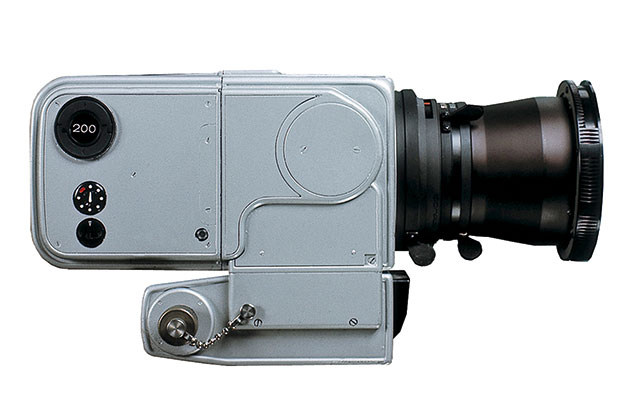
How the Hasselblad 500 EL became the Data Camera that went to the moon. Credit: Hasselblad
The mission
The Data Camera was fitted to a chest harness to allow the astronaut freedom to carry out tasks while keeping the camera in a ready position. Armstrong was the first man out of the Eagle landing module to take the first steps onto the moon’s surface. He was the one with the camera strapped to his suit, so he was the one who took the pictures. That’s why, despite Armstrong being the first man on the moon, there are so few pictures of him and so many more of Aldrin, the second man on the moon.
Remarkably, that modified 500 EL carried by Armstrong was the only camera taken onto the moon’s surface during the Apollo 11 mission and it worked perfectly. History might have been written (or photographed) differently if the shutter or motor drive had jammed, or if the lens hadn’t stopped down as required. An exposure guide was detailed on the top of each film back, with suggested apertures for a shutter speed of 1/250sec: Full shadow – 5.6, LM in shadow – 5.6, crew in sun–11, LM in sun–11. The initials LM referred to the Lunar Module and the numbers indicated f-stops. Armstrong had a rough checklist of suggested shots to be taken sewn into his glove.
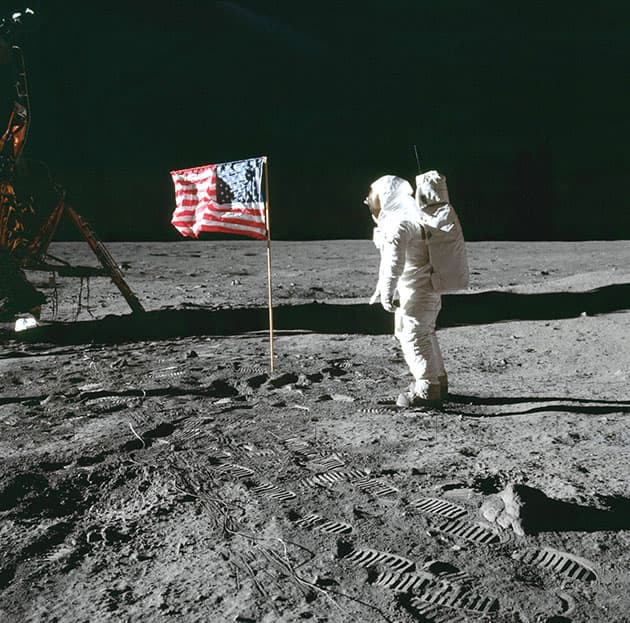
Buzz Aldrin with the US flag seeming to flutter in a non-existent breeze. Credit: NASA
The iconic pictures taken included footprints in the moon dust, the American flag seeming to utter in a non-existent breeze, and what has become known as the ‘visor shot’. This showed Aldrin standing on the surface and facing the camera with the sun behind him. Reflected in his visor, lit by the sun, is the Eagle on its landing pad, Aldrin’s shadow, experimental apparatus that had been set up and even Armstrong shooting the picture. It was a picture destined to go down in history. Record shots were taken of the tasks undertaken by the astronauts, including seismic measurements, solar wind observation, soil investigation and a collection of rock samples.
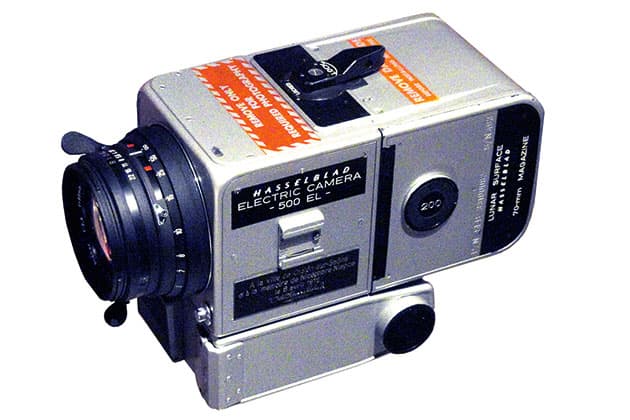
On display at the Musée Nicéphore Niépce in France, a Hasselblad 500 EL Data Camera said to be identical to that used by Neil Armstrong. Credit: Da Derot via Wikimedia Commons
After a mere two-and-a-half hours on the lunar surface Armstrong and Aldrin re-entered the landing module, where they spent time resting and sleeping before blasting off to rejoin the orbiting command module for the journey home. The camera that was taken down to the surface was left behind. Only the film backs were brought home, in order to save weight and compensate for 47 pounds of lunar surface material that was brought back.
Leaving Hasselblads behind on the lunar surface became a tradition in the years ahead. It’s thought that one Hasselblad from the Apollo 15 mission made it back, and a camera alleging to be that very one was auctioned in Vienna in 2014 with a hammer price of nearly $1,000,000. But by the time of Apollo 17 – the last moon mission in 1972 – 12 camera bodies had been left behind. Now there’s a priceless find for the first camera collector on the moon.
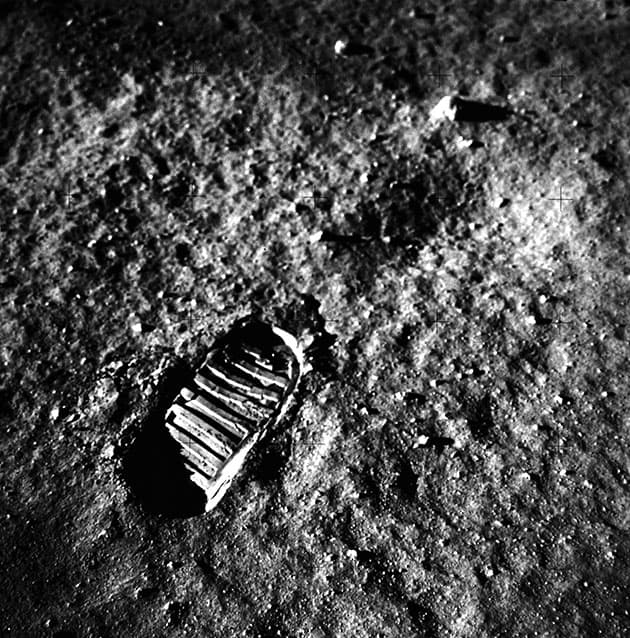
Footstep in the moon dust, shot by Neil Armstrong. Credit: NASA
Hasselblad: a brief history
Victor Hasselblad was a Swedish optical engineer and photographer, born in Gothenburg in 1906. In 1940, during the Second World War, he was asked by his government if he could manufacture an accurate copy of an aerial camera recovered from a German reconnaissance aircraft that had crashed in Sweden. It is not known exactly what that camera was, but it is likely to have been like a Luftwaffe Handkammer, a handheld aerial camera that used 80mm film. Hasselblad’s famous reply was: ‘No, but I can make a better one.’ The result was the HK-7 camera, which featured interchangeable lenses, shot 7x9cm negatives on 80mm-wide perforated film and, unlike later reflex cameras, had a direct vision viewfinder mounted on top of the body. It was the first of several military cameras produced by Hasselblad for the Swedish Air Force.

The HK-7, Hasselblad’s first camera. Credit: Hasselblad
In 1945, Hasselblad turned his attention to civilian cameras. The first model he produced, in 1948, was the 1600F, so named for its high top shutter speed of 1/1,600sec. The camera comprised a body to which could be attached an impressive range of interchangeable lenses, film backs and a variety of viewing systems. It set the tone for a long-running range of cameras known for their simplicity of use, versatility, trim dimensions, quality imaging and reliability.
The 1600F was followed by the 1000F in 1953, with a top shutter speed of 1/1,000sec. Both cameras used focal plane shutters, but with the launch of the Hasselblad 500 C, there came a shift to leaf shutters in the lenses. That was the camera that was modified for Walter Schirra to take into space for the first time. So began the legendary partnership between Hasselblad and NASA.
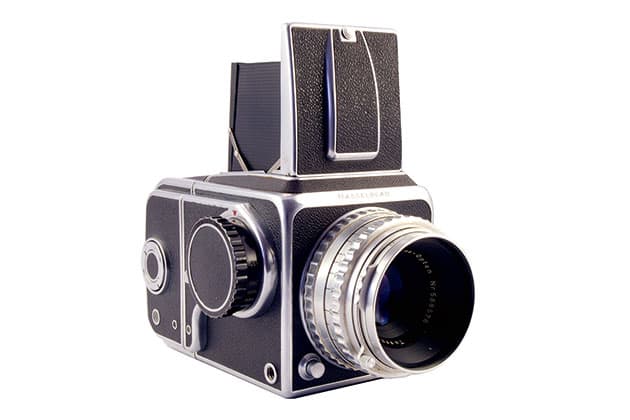
The 1600F was Hasselblad’s first civilian camera. Credit: John Wade
The Zeiss connection
The German Carl Zeiss company was founded in Jena in 1846, primarily to produce lenses, microscopes, binoculars and other optical instruments. As glass technology progressed Zeiss turned to photographic optics and built a reputation for quality, with lenses like the Zeiss Anastigmat in 1890, the Planar in 1896 and the Tessar in 1902.
In 1926, following the end of the First World War, with an infusion of capital from Zeiss, four major German camera manufacturers came together to form Zeiss Ikon, and the cameras produced by that company inevitably used Zeiss lenses, furthering the company’s reputation for excellence.
In 1940, when Victor Hasselblad produced his first camera at the request of the Swedish government, he chose a Zeiss 135mm Biotessar as its standard lens. Although Hasselblad flirted with other lens manufacturers, the association with Zeiss continued, and when Walter Schirra took the first Hasselblad into space in 1962, it went with an 80mm f/2.8 Zeiss Planar.
By the time the Hasselblad 500 EL was ready for the Apollo 11 mission, Zeiss was working hard to meet the optical challenges: special lens coatings to prevent unwanted reflections and to ensure full functions in extreme temperature fluctuations; optics that would not change in zero gravity; prevention of outgassing (the release of gas trapped or absorbed in the glass); and mechanical adaptations needed for easy operation by the astronauts.
Everyone remembers the Hasselblad cameras that went to the moon. Fewer recall the Zeiss lenses that were attached to them, the optical quality of which produced the razor-sharp images that have gone down in history.








